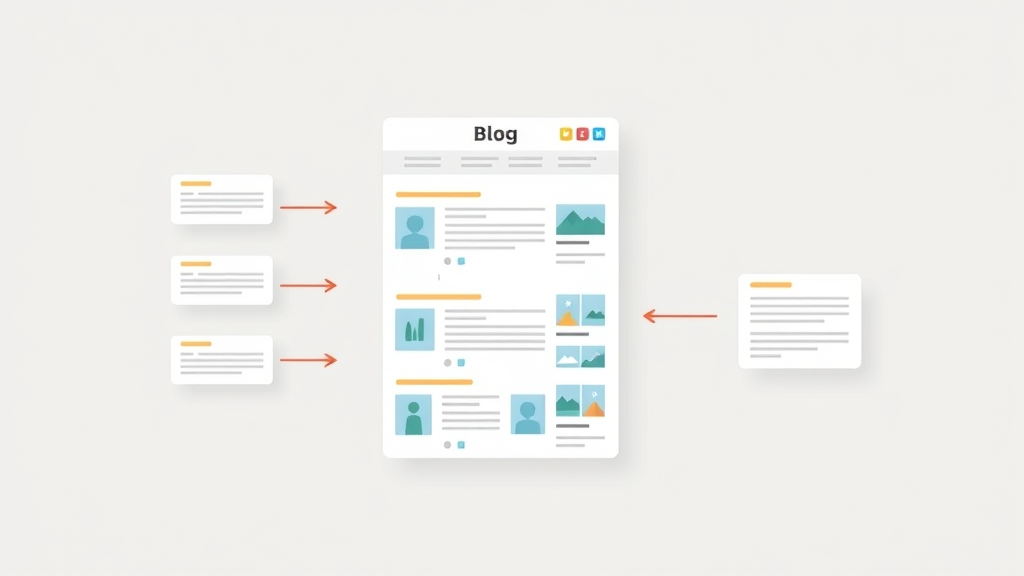Did you know? Companies who publish 16 or more blog posts per month get 3.5 times more organic traffic than those who publish four or fewer posts. That’s no small difference—consistent blogging for SEO can mean the difference between being invisible and standing out as an authority in your industry.
If you’re aiming to boost your website’s search rankings , capture more leads, and connect with your target audience , you need to master the strategic power of blogging for SEO. In this comprehensive guide, discover how to transform your blog content into a search engine magnet, harness the latest strategies (including AI!), and ensure every post works overtime for your online visibility.
Unlocking the Power of Blogging for SEO: Surprising Insights that Drive Search Engine Success
Blogging for SEO is much more than just writing website content—it’s about creating relevant, optimized blog content that search engines can’t help but rank. This means understanding how search engine algorithms work and crafting every blog post to meet both your audience’s needs and Google’s evolving standards. When done right, blog SEO doesn’t just boost your organic traffic ; it creates a content engine that feeds long-term business growth.
Search engines reward websites that offer consistently fresh, high-quality information. This is where the power of frequent, strategic blogging shines. By consistently using target keywords , optimizing for user search intent , and enhancing each page SEO element—from title tags to alt text —your website becomes a trusted resource in your niche. It’s a virtuous cycle: the more quality blog posts you publish, the more opportunities you have to rank for valuable search queries, drive organic traffic, and build topical authority.

"Companies who publish 16 or more blog posts per month get 3.5 times more organic traffic than those who publish four or fewer posts." — HubSpot
Why Blogging for SEO Works: Transform Your Blog Content into a Search Engine Magnet
- Blog post frequency and organic traffic growth: Publishing new blog posts regularly increases your page count, giving search engines more content to crawl. This frequent publishing signals to Google that your website is active and relevant, helping you rank higher and faster.
- How search engines evaluate blog content: Search engines assess blog posts using hundreds of ranking factors—including keyword relevance, content quality, internal links, and meta descriptions. Consistent optimization across these elements ensures higher search engine rankings .
- The relationship between blog SEO and rankings: Blog SEO sets the foundation for organic growth by aligning each blog post with both search engine and user expectations. This comprehensive strategy maximizes visibility in search results and drives sustained organic traffic increases over time.

Understanding the Basics: What is Blogging for SEO and How Does It Help Search Engine Optimization?
At its core, blogging for SEO refers to the creation and optimization of blog content specifically designed to improve your website’s visibility in search engine results. This process involves targeting the right keywords , ensuring each blog post is relevant to your target audience , and structuring content with keywords, internal links, title tags , and optimized meta descriptions . The ultimate goal is not just to rank for popular search queries, but to provide visitors with quality content that answers their questions and increases engagement.
The success of blog SEO relies on several elements. Effective keyword research ensures every piece targets the right audience and intent. Optimizing structural elements like headings (H1, H2, H3), using alt text on images, and writing enticing meta descriptions all contribute to helping search engines better understand and rank your content. When you create content optimized for both users and search engines, you naturally improve your search rankings, organic traffic, and ultimately conversions.
| Concept | Description |
|---|---|
| Blogging for SEO | Creating blog content optimized to rank in search engines |
| Search Engine Optimization | Techniques for improving blog posts' visibility |
| Blog SEO Elements | Title tag, meta description, internal links, alt text, keyword research |
Defining Blog SEO: Essential Elements for Effective Search Engine Optimization
A successful blog SEO strategy is built on a set of foundational SEO best practices. Effective blogs optimize every detail, from the headline structure to the smallest image alt text. By paying attention to these elements, you can make even a simple blog post highly discoverable and effective in search engine optimization . Smart bloggers know that technical details and editorial excellence go hand in hand.
Essential elements of high-performing blog content include crafting an engaging title tag and meta description to entice clicks from search results, integrating the right blend of short-tail and long-tail keywords , and weaving internal links throughout to strengthen your site structure. Enhancement doesn’t stop there; using keyword-focused alt text on images, structured formatting, and compelling introductions can further increase your visibility in Google search and boost your organic traffic.
The Anatomy of a High-Performing Blog Post for SEO

- Optimizing title tags and meta descriptions: Your title tag and meta description are often the first elements users see on Google. Make them descriptive, keyword-rich, and enticing.
- Crafting compelling blog content: Quality content informs, entertains, and solves problems for your target audience. Longer, in-depth posts often outrank shorter ones—focusing on search intent is key.
- Tail keyword integration: Seamlessly blend tail keywords throughout your content, headings, and subheadings to match real-world searches and improve relevance.
- Utilizing alt text for images: Alt text not only helps visually impaired users but also allows search engines to understand your visuals, strengthening your blog SEO.
Keyword Research for Blogging for SEO: Advanced Strategies and Actionable Tips
Keyword research is the heartbeat of any effective blog SEO strategy. Finding the best target keywords ensures you’re writing about topics people are actively searching for—maximizing your odds of ranking high in search engine results . Advanced keyword research is about more than search volume; it’s about matching your blog content to the real needs, questions, and intent of users at every stage of the funnel.
The right seo tool will help uncover high-potential long-tail keywords and assess their competition, so you’re not just another voice shouting into the void. Use tools like SEMrush, Ahrefs, or Google Keyword Planner to analyze the keywords your competitors already rank for, and identify gaps in your own content. The insights you gain from keyword research will guide your blog content planning, structure, and on-page optimization, resulting in better ranking and greater organic traffic.
What Makes Keyword Research Critical for Blog SEO Success?

- Identifying short-tail and long-tail keywords: Balance high-volume short-tail terms with more specific long-tail keywords to capture a wide range of user queries and boost ranking chances.
- Matching target audience and search intent: Select keywords that align with what your audience actually needs, focusing on questions and problems they care about most.
- Using top SEO tools for effective research: Invest in reliable tools for deep data analysis, competition research, and ongoing content opportunity discovery.
How to Plan Blog Content That Ranks: Understanding Search Engine Algorithms
"Writing high-quality, relevant blog content that matches search intent is the cornerstone of modern SEO."

Planning blog content that achieves top rankings requires a deep understanding of how search engines interpret and rank blog posts. Google’s search algorithm looks for content that not only satisfies the user’s query but demonstrates authority, expertise, and trustworthiness. These factors—often referred to as “E-A-T”—play a critical role in today’s SEO landscape.
When designing your content strategy, go beyond keyword stuffing and focus on search intent . Create content clusters around core topics, and ensure each blog post contributes to a broader content ecosystem. Analyzing search data and identifying what’s already ranking in your niche will give you clear direction for new blog content, optimizing for both user satisfaction and search engine algorithms.
Aligning Blog Posts with Search Intent and Organic Traffic Goals
- Analyzing search engine data: Use Google Search Console and analytics to spot new keyword opportunities, track successful blog posts, and identify content gaps based on actual user searches.
- Content creation for organic growth: Develop topics that address each stage of the user journey—from informational queries to commercial investigations—targeting both short-tail and long-tail keywords for sustained organic traffic growth.
- Tailoring posts for featured snippet opportunities: Research featured snippet formats in your niche, then structure your content (with lists, tables, and concise answers) to capture these high-visibility placements.
Optimizing Every Blog Post: On-Page SEO Techniques for Top Rankings
On-page optimization is the process of fine-tuning every element of your blog post for maximum search engine visibility. From the headline to image alt text, every detail can impact your chances of reaching page one in Google. Consistent on-page SEO across your blog content will elevate your domain authority, improve click-through rates, and increase average time on page (which can boost SEO even further).
Paying attention to meta descriptions , strategic keyword placement, formatting headers, and building effective internal links helps both search engines and users find value in your content—delivering a better user experience, reducing bounce rate, and supporting sustained ranking improvements.
Crafting SEO-Friendly Title Tags, Meta Descriptions, and Alt Text

- Creating engaging meta descriptions: Write clear, action-oriented meta descriptions with target keywords and a compelling call to action to attract higher click-through rates.
- Using effective alt text for accessibility: Alt text should be concise, relevant, and incorporate target keywords when natural—helping search engines interpret your visuals and improving accessibility.
- Formatting headers for search engine crawlers: Structure your blog posts with logical H2/H3 headings, using target keywords, to make your content easy to scan for both users and search engines.
Internal Links: Amplifying Blog SEO and Enhancing User Engagement
- Structuring internal links for page SEO: Thoughtful internal linking distributes authority across key posts, keeps users clicking, and makes your whole site easier to crawl.
- Building topical authority across your blog posts: Strategic internal links between related blog posts help establish your website as a resource hub, boosting both topical authority and organic search performance.
Content Structure and Formatting: Make Your Blog Posts SEO-Friendly
How your blog post is structured has a direct impact on SEO performance. Hierarchical headlines allow search engines to parse your content, understand its organization, and rank your blog posts more effectively. Well-laid-out posts—with lists, tables, and multimedia—improve readability, keep users engaged, and lower bounce rates.
Formatting with bullet points, concise paragraphs, and visual elements doesn’t just improve user experience; it creates more entry points for organic rankings (e.g., featured snippets). Using tables to summarize key data and embedding images with alt text helps both users and search engines extract maximum value from your content.
- Hierarchical headlines for search engine optimization
- Readable layouts for blog content
- Utilizing lists, tables, and multimedia

Measuring Success: How to Track Blogging for SEO Performance and Optimize Results
The only way to refine your blogging for SEO strategy is to measure what’s working and optimize based on hard data. Dedicated SEO tools let you monitor page SEO metrics, track organic traffic, evaluate post performance, and measure conversions. By following your analytics, you’ll gain actionable insights into which blog posts are strengthening your search presence—and which need improvement.
Focus on key performance metrics such as total organic traffic, average page position, bounce rate, average time on page, and the conversion rate of blog-driven leads. Adjust your blogging efforts, keyword targets, and content themes according to this feedback to maintain and grow your organic search ranking.
SEO Tools and Metrics: Monitoring Blog Post Impact on Search Engine Rankings

- Tools for page SEO analytics: Use platforms like Google Analytics, Search Console, and specialist tools such as SEMrush or Ahrefs to track search engine rankings for each blog post.
- Evaluating organic traffic and conversions: Monitor how your blog content is driving new visitors and sales. Identify which posts generate the most leads and engagement.
- Adjusting strategies based on data insights: Regularly review what’s working and pivot your content plan to focus on proven SEO winners while refreshing or updating underperforming posts.
Advanced Techniques: Leveraging Blog SEO to Capture Featured Snippet Placements
Capturing featured snippet placements can give your blog posts the top spot in Google’s search results. Structuring your blog content for these snippets—using lists, tables, and clearly marked answer boxes—increases your chances of earning these high-visibility positions and dramatically boosts your organic traffic.
Optimize for snippets by researching common queries in your niche and providing concise, authoritative answers near the top of your posts. Use clear formatting, data tables, and bullet points to facilitate Google’s extraction for snippet display.
How to Structure Content for Featured Snippets in Search Engines
- Answering common queries in concise formats: Summarize complex answers in 40-50 words at the start of relevant blog posts.
- Using tables, lists, and bullet points: Structures like these help search engines easily identify the content suitable for featured snippet boxes.
- Marking up content for snippet eligibility: Use schema, proper HTML markup, and heading tags to improve your chances of capturing featured snippets.

Common Blogging for SEO Mistakes and How to Avoid Them
- Over-optimizing with keywords: Stuffing your blog posts with too many keywords can actually harm rankings and alienate readers. Opt for natural keyword integration focused on search intent.
- Ignoring user experience: Slow-loading pages, confusing layouts, and walls of text drive up bounce rates. Always prioritize clarity and usability.
- Neglecting meta description and alt text elements: Skipping these critical SEO components can cost you valuable organic click-throughs and limit the impact of your visuals.
The Future of Blogging for SEO: Trends, AI Power, and Content Velocity
"AI-driven content optimization is setting a new standard for blog SEO, making quality and speed more important than ever."

The pace of change in search engine optimization is accelerating, driven in large part by advances in artificial intelligence. Today, AI tools analyze search intent, predict trending topics, and even help automate content creation—giving marketers an unprecedented edge in the race for rankings and organic traffic. As content velocity becomes a bigger ranking factor, those who use AI to scale high-quality blog SEO will pull ahead.
The most successful blogs in the coming years will harness AI-powered insights to publish faster, smarter, and with greater focus on user intent and search engine requirements. This new era of blogging for SEO is about combining creativity, data-driven strategy, and technological tools to create a sustained competitive advantage.
How AI Is Changing SEO and Search Engine Strategies
- Leveraging AI tools for content planning: AI tools identify keyword trends, map out content clusters, and recommend topics based on real search data.
- Increasing blog post publishing velocity for better search engine visibility: Automating content workflows enables faster publishing and increased topical authority in your niche.
Maximizing Your Results: Case Studies and Real-World Blogging for SEO Success
| Case Study | Approach | Results |
|---|---|---|
| SaaS Company | Increased blog content and tailored for search intent | 220% organic traffic growth in 6 months |
| E-commerce Blog | Featured snippet optimization | 50% boost in click-through rate |
These case studies demonstrate the real-world power of strategic blogging for SEO. By focusing on content velocity , search intent, and on-page SEO elements like featured snippets and alt text, brands can achieve remarkable growth—even in highly competitive industries. The lessons are clear: consistent, optimized content creation pays off.
Notice how both businesses supplemented their efforts with ongoing keyword research, structured internal links, and data-driven updates to old blog posts. Think of blogging as an evolving strategy, not a one-off project—continuous improvement is the path to outpacing your competitors in organic search.
Is blogging good for SEO?
Absolutely. Blogging for SEO drives more organic traffic by providing fresh, relevant content that matches user search intent. Each well-optimized blog post adds new entry points for users on Google and helps improve your website’s overall authority.
What is SEO in blogging?
SEO in blogging means optimizing your blog content so it ranks high in search engine results. This involves keyword research, using internal links , optimizing meta descriptions and title tags, and structuring posts for both users and search engines.
Is blogging for SEO dead?
Not at all! Blogging for SEO is evolving, not dying. With new strategies like AI-powered content and featured snippet optimization, consistent blogging remains one of the best ways to boost your rankings and organic traffic.
How to write blogs for SEO?
Research your target keywords and search intent , craft high-quality content around them, structure posts with logical headings, use internal links, optimize with descriptive meta descriptions and alt text , and update older posts over time.
Frequently Asked Questions About Blogging for SEO
-
How many blog posts are needed for SEO results?
SEO results can begin with just a few well-optimized blog posts, but consistent publishing (at least 2-4 posts per week) accelerates organic traffic growth and authority building. -
Which SEO tools help automate blogging strategies?
Tools like SEMrush, Ahrefs, Clearscope, and SurferSEO help automate keyword research, content optimization, and performance tracking for your blog SEO. -
What are the best practices for alt text in blog images?
Use concise, descriptive language and include target keywords when relevant. Alt text should explain the image’s purpose and its relationship to the blog post topic. -
Should you update old blog content for better SEO?
Yes. Regularly update outdated information, optimize for new keywords, and refresh meta descriptions to continually boost your blog posts’ visibility in search engines.
Key Strategies Recap: Implement These Blogging for SEO Techniques Today
- Consistently publish keyword-optimized content
- Prioritize user search intent
- Leverage internal links and effective meta descriptions
- Harness AI for content planning and increased content velocity
Ready to Transform Your Rankings? Harness the New Era of Blogging for SEO
As AI powers visibilty, traditional SEO becomes less and less valuable. Blogging is the new visibility, and content velocity is the key to its leverage. Learn more with Stratalyst AI at https://stratalystai.com .
What you'll learn
- The fundamentals and latest techniques in blogging for SEO
- How to conduct advanced keyword research for blog SEO
- Optimizing blog content for search engine algorithms
- Strategies for maximizing organic traffic and achieving top rankings
- The impact of AI and content velocity on SEO success
Visual Guide: Blogging for SEO Best Practices Video
Step-by-step walkthrough of best practices for blogging for SEO, including keyword research, content optimization, and live on-page SEO improvements, using screen recordings, voiceover, and visual highlights.
Video Demonstration: Keyword Research Tools for Blog SEO
Watch a detailed demonstration of how to use the top keyword research tools to find high-value keywords for your blog SEO strategy, featuring up-to-date examples and live walkthroughs.
Start today—publish often, optimize every detail, and embrace AI to supercharge your blogging for SEO. Consistent action delivers compounding search results, helping your business secure top rankings faster than ever before.
 Add Row
Add Row  Add
Add 




Write A Comment